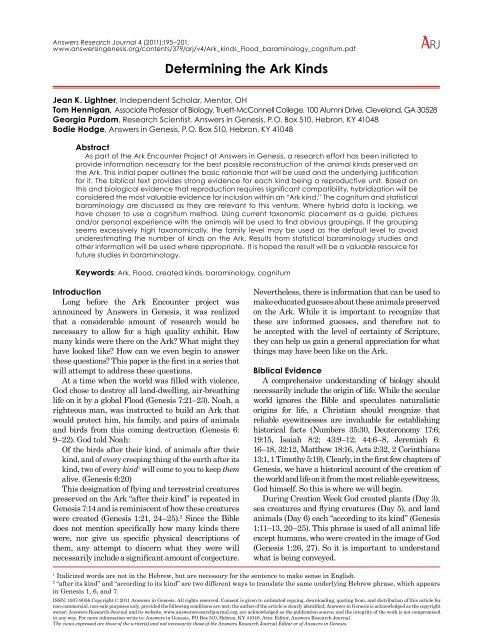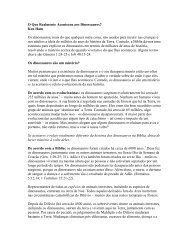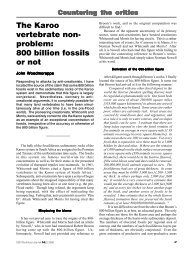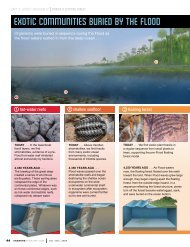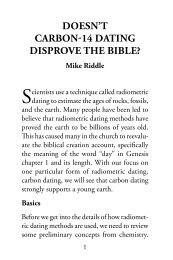Determining the Ark Kinds - Answers in Genesis
Determining the Ark Kinds - Answers in Genesis
Determining the Ark Kinds - Answers in Genesis
Create successful ePaper yourself
Turn your PDF publications into a flip-book with our unique Google optimized e-Paper software.
<strong>Answers</strong> Research Journal 4 (2011):195–201.<br />
www.answers<strong>in</strong>genesis.org/contents/379/arj/v4/<strong>Ark</strong>_k<strong>in</strong>ds_Flood_baram<strong>in</strong>ology_cognitum.pdf<br />
<strong>Determ<strong>in</strong><strong>in</strong>g</strong> <strong>the</strong> <strong>Ark</strong> <strong>K<strong>in</strong>ds</strong><br />
Jean K. Lightner, Independent Scholar, Mentor, OH<br />
Tom Hennigan, Associate Professor of Biology, Truett-McConnell College, 100 Alumni Drive, Cleveland, GA 30528<br />
Georgia Purdom, Research Scientist, <strong>Answers</strong> <strong>in</strong> <strong>Genesis</strong>, P. O. Box 510, Hebron, KY 41048<br />
Bodie Hodge, <strong>Answers</strong> <strong>in</strong> <strong>Genesis</strong>, P. O. Box 510, Hebron, KY 41048<br />
Abstract<br />
As part of <strong>the</strong> <strong>Ark</strong> Encounter Project at <strong>Answers</strong> <strong>in</strong> <strong>Genesis</strong>, a research effort has been <strong>in</strong>itiated to<br />
provide <strong>in</strong>formation necessary for <strong>the</strong> best possible reconstruction of <strong>the</strong> animal k<strong>in</strong>ds preserved on<br />
<strong>the</strong> <strong>Ark</strong>. This <strong>in</strong>itial paper outl<strong>in</strong>es <strong>the</strong> basic rationale that will be used and <strong>the</strong> underly<strong>in</strong>g justification<br />
for it. The biblical text provides strong evidence for each k<strong>in</strong>d be<strong>in</strong>g a reproductive unit. Based on<br />
this and biological evidence that reproduction requires significant compatibility, hybridization will be<br />
considered <strong>the</strong> most valuable evidence for <strong>in</strong>clusion with<strong>in</strong> an “<strong>Ark</strong> k<strong>in</strong>d.” The cognitum and statistical<br />
baram<strong>in</strong>ology are discussed as <strong>the</strong>y are relevant to this venture. Where hybrid data is lack<strong>in</strong>g, we<br />
have chosen to use a cognitum method. Us<strong>in</strong>g current taxonomic placement as a guide, pictures<br />
and/or personal experience with <strong>the</strong> animals will be used to f<strong>in</strong>d obvious group<strong>in</strong>gs. If <strong>the</strong> group<strong>in</strong>g<br />
seems excessively high taxonomically, <strong>the</strong> family level may be used as <strong>the</strong> default level to avoid<br />
underestimat<strong>in</strong>g <strong>the</strong> number of k<strong>in</strong>ds on <strong>the</strong> <strong>Ark</strong>. Results from statistical baram<strong>in</strong>ology studies and<br />
o<strong>the</strong>r <strong>in</strong>formation will be used where appropriate. It is hoped <strong>the</strong> result will be a valuable resource for<br />
future studies <strong>in</strong> baram<strong>in</strong>ology.<br />
Keywords: <strong>Ark</strong>, Flood, created k<strong>in</strong>ds, baram<strong>in</strong>ology, cognitum<br />
Introduction<br />
Long before <strong>the</strong> <strong>Ark</strong> Encounter project was<br />
announced by <strong>Answers</strong> <strong>in</strong> <strong>Genesis</strong>, it was realized<br />
that a considerable amount of research would be<br />
necessary to allow for a high quality exhibit. How<br />
many k<strong>in</strong>ds were <strong>the</strong>re on <strong>the</strong> <strong>Ark</strong>? What might <strong>the</strong>y<br />
have looked like? How can we even beg<strong>in</strong> to answer<br />
<strong>the</strong>se questions? This paper is <strong>the</strong> first <strong>in</strong> a series that<br />
will attempt to address <strong>the</strong>se questions.<br />
At a time when <strong>the</strong> world was filled with violence,<br />
God chose to destroy all land-dwell<strong>in</strong>g, air-breath<strong>in</strong>g<br />
life on it by a global Flood (<strong>Genesis</strong> 7:21–23). Noah, a<br />
righteous man, was <strong>in</strong>structed to build an <strong>Ark</strong> that<br />
would protect him, his family, and pairs of animals<br />
and birds from this com<strong>in</strong>g destruction (<strong>Genesis</strong> 6:<br />
9–22). God told Noah:<br />
Of <strong>the</strong> birds after <strong>the</strong>ir k<strong>in</strong>d, of animals after <strong>the</strong>ir<br />
k<strong>in</strong>d, and of every creep<strong>in</strong>g th<strong>in</strong>g of <strong>the</strong> earth after its<br />
k<strong>in</strong>d, two of every k<strong>in</strong>d 1 will come to you to keep <strong>the</strong>m<br />
alive. (<strong>Genesis</strong> 6:20)<br />
This designation of fly<strong>in</strong>g and terrestrial creatures<br />
preserved on <strong>the</strong> <strong>Ark</strong> “after <strong>the</strong>ir k<strong>in</strong>d” is repeated <strong>in</strong><br />
<strong>Genesis</strong> 7:14 and is rem<strong>in</strong>iscent of how <strong>the</strong>se creatures<br />
were created (<strong>Genesis</strong> 1:21, 24–25). 2 S<strong>in</strong>ce <strong>the</strong> Bible<br />
does not mention specifically how many k<strong>in</strong>ds <strong>the</strong>re<br />
were, nor give us specific physical descriptions of<br />
<strong>the</strong>m, any attempt to discern what <strong>the</strong>y were will<br />
necessarily <strong>in</strong>clude a significant amount of conjecture.<br />
Never<strong>the</strong>less, <strong>the</strong>re is <strong>in</strong>formation that can be used to<br />
make educated guesses about <strong>the</strong>se animals preserved<br />
on <strong>the</strong> <strong>Ark</strong>. While it is important to recognize that<br />
<strong>the</strong>se are <strong>in</strong>formed guesses, and <strong>the</strong>refore not to<br />
be accepted with <strong>the</strong> level of certa<strong>in</strong>ty of Scripture,<br />
<strong>the</strong>y can help us ga<strong>in</strong> a general appreciation for what<br />
th<strong>in</strong>gs may have been like on <strong>the</strong> <strong>Ark</strong>.<br />
Biblical Evidence<br />
A comprehensive understand<strong>in</strong>g of biology should<br />
necessarily <strong>in</strong>clude <strong>the</strong> orig<strong>in</strong> of life. While <strong>the</strong> secular<br />
world ignores <strong>the</strong> Bible and speculates naturalistic<br />
orig<strong>in</strong>s for life, a Christian should recognize that<br />
reliable eyewitnesses are <strong>in</strong>valuable for establish<strong>in</strong>g<br />
historical facts (Numbers 35:30, Deuteronomy 17:6;<br />
19:15, Isaiah 8:2; 43:9–12; 44:6–8, Jeremiah 6:<br />
16–18, 32:12, Mat<strong>the</strong>w 18:16, Acts 2:32, 2 Cor<strong>in</strong>thians<br />
13:1, 1 Timothy 5:19). Clearly, <strong>in</strong> <strong>the</strong> first few chapters of<br />
<strong>Genesis</strong>, we have a historical account of <strong>the</strong> creation of<br />
<strong>the</strong> world and life on it from <strong>the</strong> most reliable eyewitness,<br />
God himself. So this is where we will beg<strong>in</strong>.<br />
Dur<strong>in</strong>g Creation Week God created plants (Day 3),<br />
sea creatures and fly<strong>in</strong>g creatures (Day 5), and land<br />
animals (Day 6) each “accord<strong>in</strong>g to its k<strong>in</strong>d” (<strong>Genesis</strong><br />
1:11–13, 20–25). This phrase is used of all animal life<br />
except humans, who were created <strong>in</strong> <strong>the</strong> image of God<br />
(<strong>Genesis</strong> 1:26, 27). So it is important to understand<br />
what is be<strong>in</strong>g conveyed.<br />
1 Italicized words are not <strong>in</strong> <strong>the</strong> Hebrew, but are necessary for <strong>the</strong> sentence to make sense <strong>in</strong> English.<br />
2 “after its k<strong>in</strong>d” and “accord<strong>in</strong>g to its k<strong>in</strong>d” are two different ways to translate <strong>the</strong> same underly<strong>in</strong>g Hebrew phrase, which appears<br />
<strong>in</strong> <strong>Genesis</strong> 1, 6, and 7.<br />
ISSN: 1937-9056 Copyright © 2011 <strong>Answers</strong> <strong>in</strong> <strong>Genesis</strong>. All rights reserved. Consent is given to unlimited copy<strong>in</strong>g, download<strong>in</strong>g, quot<strong>in</strong>g from, and distribution of this article for<br />
non-commercial, non-sale purposes only, provided <strong>the</strong> follow<strong>in</strong>g conditions are met: <strong>the</strong> author of <strong>the</strong> article is clearly identified; <strong>Answers</strong> <strong>in</strong> <strong>Genesis</strong> is acknowledged as <strong>the</strong> copyright<br />
owner; <strong>Answers</strong> Research Journal and its website, www.answersresearchjournal.org, are acknowledged as <strong>the</strong> publication source; and <strong>the</strong> <strong>in</strong>tegrity of <strong>the</strong> work is not compromised<br />
<strong>in</strong> any way. For more <strong>in</strong>formation write to: <strong>Answers</strong> <strong>in</strong> <strong>Genesis</strong>, PO Box 510, Hebron, KY 41048, Attn: Editor, <strong>Answers</strong> Research Journal.<br />
The views expressed are those of <strong>the</strong> writer(s) and not necessarily those of <strong>the</strong> <strong>Answers</strong> Research Journal Editor or of <strong>Answers</strong> <strong>in</strong> <strong>Genesis</strong>.
196<br />
The underly<strong>in</strong>g Hebrew word for k<strong>in</strong>d here is ןימ,<br />
mîn. It, along with <strong>the</strong> Hebrew word for create (ארב,<br />
bārā’), was used to co<strong>in</strong> <strong>the</strong> word baram<strong>in</strong>, a creationist<br />
term for created k<strong>in</strong>d. While <strong>the</strong> word baram<strong>in</strong> has<br />
strong taxonomic connotations to most creationists,<br />
Hebrew scholars have warned aga<strong>in</strong>st assum<strong>in</strong>g that<br />
ןימ is a technical term (Turner 2009; Williams 1997).<br />
Both Williams (1997) and Turner (2009) suggest that<br />
ןימ can be understood to refer to subdivisions with<strong>in</strong><br />
a larger group much like <strong>the</strong> mean<strong>in</strong>g of <strong>the</strong> English<br />
word k<strong>in</strong>d. So caution needs to be exercised <strong>in</strong> this<br />
area.<br />
Plants are described as be<strong>in</strong>g created accord<strong>in</strong>g to<br />
<strong>the</strong>ir k<strong>in</strong>ds with seed (ערז, zera’), imply<strong>in</strong>g <strong>the</strong>y were<br />
to reproduce (<strong>Genesis</strong> 1:11–12). Aquatic and fly<strong>in</strong>g<br />
creatures, after be<strong>in</strong>g created accord<strong>in</strong>g to <strong>the</strong>ir k<strong>in</strong>ds,<br />
were blessed and told to reproduce to fill <strong>the</strong> earth<br />
(<strong>Genesis</strong> 1:22). A similar bless<strong>in</strong>g was pronounced<br />
on humans (<strong>Genesis</strong> 1:28) along with a command<br />
for <strong>the</strong>m to rule <strong>the</strong> earth. S<strong>in</strong>ce life was created<br />
“accord<strong>in</strong>g to <strong>the</strong>ir k<strong>in</strong>ds” and told to reproduce, it is<br />
often assumed that life reproduces accord<strong>in</strong>g to its<br />
k<strong>in</strong>d. While Scripture does not emphatically state<br />
that life reproduces only after its own k<strong>in</strong>d, <strong>the</strong>re is a<br />
very strong <strong>in</strong>ference given both <strong>the</strong> biblical text and<br />
observations made <strong>in</strong> <strong>the</strong> world today.<br />
The account of <strong>the</strong> Flood seems to re<strong>in</strong>force this<br />
understand<strong>in</strong>g. God told Noah:<br />
And of every liv<strong>in</strong>g th<strong>in</strong>g of all flesh you shall br<strong>in</strong>g<br />
two of every sort <strong>in</strong>to <strong>the</strong> ark, to keep <strong>the</strong>m alive with<br />
you; <strong>the</strong>y shall be male and female. Of <strong>the</strong> birds after<br />
<strong>the</strong>ir k<strong>in</strong>d, of animals after <strong>the</strong>ir k<strong>in</strong>d, and of every<br />
creep<strong>in</strong>g th<strong>in</strong>g of <strong>the</strong> earth after its k<strong>in</strong>d, two of every<br />
k<strong>in</strong>d will come to you to keep <strong>the</strong>m alive. (<strong>Genesis</strong><br />
6:19–20).<br />
Notice verse 19 mentions two of all liv<strong>in</strong>g th<strong>in</strong>gs,<br />
a male and a female, are to come on <strong>the</strong> <strong>Ark</strong>. The<br />
obvious purpose is for reproduction (cf. <strong>Genesis</strong> 7:2,<br />
3, and 9). This is adjacent to a verse mention<strong>in</strong>g <strong>the</strong><br />
preservation of animals accord<strong>in</strong>g to <strong>the</strong>ir k<strong>in</strong>ds,<br />
aga<strong>in</strong> specify<strong>in</strong>g two of each. A very similar situation<br />
is found <strong>in</strong> <strong>the</strong> next chapter.<br />
<strong>the</strong>y [Noah and family] and every beast after its k<strong>in</strong>d,<br />
all cattle after <strong>the</strong>ir k<strong>in</strong>d, every creep<strong>in</strong>g th<strong>in</strong>g that<br />
creeps on <strong>the</strong> earth after its k<strong>in</strong>d, and every bird after<br />
its k<strong>in</strong>d, every bird of every sort. And <strong>the</strong>y went <strong>in</strong>to<br />
<strong>the</strong> ark to Noah, two by two, of all flesh <strong>in</strong> which is <strong>the</strong><br />
breath of life. So those that entered, male and female<br />
of all flesh, went <strong>in</strong> as God had commanded him; and<br />
<strong>the</strong> LORD shut him <strong>in</strong>. (<strong>Genesis</strong> 7:14–16)<br />
These pairs of animals were brought on <strong>the</strong> <strong>Ark</strong><br />
for <strong>the</strong> purpose of preserv<strong>in</strong>g <strong>the</strong>ir seed (<strong>Genesis</strong> 7:3;<br />
ערז, zera’). Word-for-word translations render ערז as<br />
offspr<strong>in</strong>g (for example New American Standard Bible,<br />
J. K. Lightner, T. Hennigan, G. Purdom, and B. Hodge<br />
English Standard Version, New English Translation),<br />
clarify<strong>in</strong>g th<strong>in</strong>gs s<strong>in</strong>ce <strong>the</strong> modern English word<br />
“seed” has a narrower semantic range than <strong>the</strong><br />
Hebrew word. The New International Version, which<br />
is more of a dynamic equivalence translation, renders<br />
<strong>the</strong> encompass<strong>in</strong>g phrase: “to keep <strong>the</strong>ir various<br />
k<strong>in</strong>ds alive throughout <strong>the</strong> earth.” Thus, where ןימ is<br />
used <strong>in</strong> <strong>the</strong> Creation or Flood accounts, it seems to be<br />
referr<strong>in</strong>g to dist<strong>in</strong>ct groups of animals and strongly<br />
imply<strong>in</strong>g that reproduction occurs with<strong>in</strong> <strong>the</strong>se<br />
groups (Table 1).<br />
Methods for Ascerta<strong>in</strong><strong>in</strong>g Baram<strong>in</strong>s<br />
(Created <strong>K<strong>in</strong>ds</strong>)<br />
Hybridization<br />
Based on <strong>the</strong> concept that liv<strong>in</strong>g th<strong>in</strong>gs reproduce<br />
accord<strong>in</strong>g to <strong>the</strong>ir k<strong>in</strong>ds, hybrids between different<br />
species of animals has long been considered conclusive<br />
evidence that both species belong to <strong>the</strong> same created<br />
k<strong>in</strong>d (baram<strong>in</strong>). For example, crosses between dogs<br />
and wolves, wolves and coyotes, and coyotes and<br />
jackals are <strong>in</strong>terpreted to mean that all <strong>the</strong>se species<br />
of animals belong to a s<strong>in</strong>gle baram<strong>in</strong>.<br />
Reproduction is a complex process and sometimes<br />
barriers arise that make it more difficult. This can<br />
be seen <strong>in</strong> attempts to form hybrids between different<br />
species. When cattle are crossed with bison, live<br />
hybrids are formed. However, <strong>the</strong> males are sterile.<br />
The females can generally reproduce and can be<br />
crossed with ei<strong>the</strong>r parent species. For this reason,<br />
cattle and bison are considered to belong to <strong>the</strong> same<br />
baram<strong>in</strong>, but are not <strong>the</strong> same species because <strong>the</strong>y<br />
cannot consistently produce fertile offspr<strong>in</strong>g. Crosses<br />
between horses and donkeys produce a mule, which is<br />
rarely fertile <strong>in</strong> ei<strong>the</strong>r sex.<br />
More serious barriers to reproduction can be apparent<br />
with<strong>in</strong> a baram<strong>in</strong>. Sheep and goats were identified as<br />
belong<strong>in</strong>g to <strong>the</strong> same baram<strong>in</strong> because several live<br />
hybrids have been produced between <strong>the</strong>m. However,<br />
a live hybrid is not <strong>the</strong> most common result when<br />
<strong>the</strong>se species mate with each o<strong>the</strong>r. In one study, when<br />
rams were mated with does (female goats) fertilization<br />
was fairly common, although not as high as mat<strong>in</strong>gs<br />
with<strong>in</strong> <strong>the</strong> respective species. The hybrid embryos died<br />
with<strong>in</strong> 5 to 10 weeks. When <strong>the</strong> cross was made <strong>the</strong><br />
o<strong>the</strong>r direction, bucks (male goats) mated with ewes,<br />
fertilization did not occur (Kelk et al. 1997).<br />
So how much development is necessary for<br />
hybridization to be considered successful? Is<br />
fertilization enough? The answer to <strong>the</strong> latter question<br />
is clearly no, as human sperm can fertilize hamster<br />
eggs <strong>in</strong> <strong>the</strong> laboratory. 3 Even <strong>the</strong> first few divisions<br />
are under maternal control. For this reason Scherer<br />
(1993) stated that embryogenesis must cont<strong>in</strong>ue until<br />
3 It should be noted that just because we report on <strong>the</strong> results of certa<strong>in</strong> laboratory f<strong>in</strong>d<strong>in</strong>gs does not necessarily imply we believe<br />
a specific procedure is ethical.
<strong>Determ<strong>in</strong><strong>in</strong>g</strong> <strong>the</strong> <strong>Ark</strong> <strong>K<strong>in</strong>ds</strong><br />
Table 1. Passages discuss<strong>in</strong>g reproduction <strong>in</strong> k<strong>in</strong>ds at Creation and <strong>the</strong> Flood.<br />
Subject Passage<br />
Vegetation<br />
Sea creatures<br />
Fly<strong>in</strong>g creatures<br />
Land animals<br />
(on <strong>Ark</strong>)<br />
<strong>Genesis</strong> 1:12<br />
And <strong>the</strong> earth brought forth grass, <strong>the</strong> herb that<br />
yields seed accord<strong>in</strong>g to its k<strong>in</strong>d, and <strong>the</strong> tree<br />
that yields fruit, whose seed is <strong>in</strong> itself accord<strong>in</strong>g<br />
to its k<strong>in</strong>d. And God saw that it was good.<br />
<strong>Genesis</strong> 1:21–22<br />
So God created great sea creatures and every<br />
liv<strong>in</strong>g th<strong>in</strong>g that moves, with which <strong>the</strong> waters<br />
abounded, accord<strong>in</strong>g to <strong>the</strong>ir k<strong>in</strong>d, and every<br />
w<strong>in</strong>ged bird accord<strong>in</strong>g to its k<strong>in</strong>d. And God<br />
saw that it was good. And God blessed <strong>the</strong>m,<br />
say<strong>in</strong>g, “Be fruitful and multiply, and fill <strong>the</strong><br />
waters <strong>in</strong> <strong>the</strong> seas, and let birds multiply on <strong>the</strong><br />
earth.”<br />
<strong>Genesis</strong> 1:21–22<br />
So God created great sea creatures and every<br />
liv<strong>in</strong>g th<strong>in</strong>g that moves, with which <strong>the</strong> waters<br />
abounded, accord<strong>in</strong>g to <strong>the</strong>ir k<strong>in</strong>d, and every<br />
w<strong>in</strong>ged bird accord<strong>in</strong>g to its k<strong>in</strong>d. And God<br />
saw that it was good. And God blessed <strong>the</strong>m,<br />
say<strong>in</strong>g, “Be fruitful and multiply, and fill <strong>the</strong><br />
waters <strong>in</strong> <strong>the</strong> seas, and let birds multiply on <strong>the</strong><br />
earth.”<br />
<strong>Genesis</strong> 8:17<br />
Br<strong>in</strong>g out with you every liv<strong>in</strong>g th<strong>in</strong>g of all flesh<br />
that is with you: birds and cattle and every<br />
creep<strong>in</strong>g th<strong>in</strong>g that creeps on <strong>the</strong> earth, so that<br />
<strong>the</strong>y may abound on <strong>the</strong> earth, and be fruitful<br />
and multiply on <strong>the</strong> earth.<br />
<strong>Genesis</strong> 6:19–20<br />
And of every liv<strong>in</strong>g th<strong>in</strong>g of all flesh you shall<br />
br<strong>in</strong>g two of every sort <strong>in</strong>to <strong>the</strong> ark, to keep<br />
<strong>the</strong>m alive with you; <strong>the</strong>y shall be male and<br />
female. Of <strong>the</strong> birds after <strong>the</strong>ir k<strong>in</strong>d, of animals<br />
after <strong>the</strong>ir k<strong>in</strong>d, and of every creep<strong>in</strong>g th<strong>in</strong>g of<br />
<strong>the</strong> earth after its k<strong>in</strong>d, two of every k<strong>in</strong>d will<br />
come to you to keep <strong>the</strong>m alive.<br />
<strong>Genesis</strong> 8:17<br />
Br<strong>in</strong>g out with you every liv<strong>in</strong>g th<strong>in</strong>g of all flesh<br />
that is with you: birds and cattle and every<br />
creep<strong>in</strong>g th<strong>in</strong>g that creeps on <strong>the</strong> earth, so that<br />
<strong>the</strong>y may abound on <strong>the</strong> earth, and be fruitful<br />
and multiply on <strong>the</strong> earth.<br />
<strong>the</strong>re is coord<strong>in</strong>ated expression of both maternal<br />
and paternal morphogenetic genes. Lightner (2007)<br />
suggested that <strong>the</strong> advanced blastocyst stage may<br />
be sufficient. This was partially based on a study<br />
by Patil and Totey (2003) which showed failure of<br />
embryos around <strong>the</strong> 8 cell stage was associated with a<br />
lack of mRNA transcripts. Thus it seemed significant<br />
coord<strong>in</strong>ated expression was necessary to advance<br />
past this stage, through <strong>the</strong> morula stage, to a late<br />
blastocyst.<br />
This br<strong>in</strong>gs us to some limitations of hybridization<br />
<strong>in</strong> determ<strong>in</strong><strong>in</strong>g k<strong>in</strong>ds. While well documented hybrids<br />
can confirm that two species belong to <strong>the</strong> same<br />
baram<strong>in</strong>, lack of hybridization data is <strong>in</strong>conclusive.<br />
There are several reasons why hybrid data may<br />
Reproduction Mentioned—<br />
<strong>Genesis</strong> 1?<br />
Yes, seeds<br />
Yes: be fruitful and multiply<br />
197<br />
Reproduction Mentioned—<br />
<strong>Genesis</strong> 6–9?<br />
Yes: be fruitful and multiply Yes: be fruitful and multiply<br />
Yes: a k<strong>in</strong>d is represented<br />
on <strong>the</strong> <strong>Ark</strong> by a male and its<br />
mate; be fruitful and multiply<br />
be lack<strong>in</strong>g between <strong>in</strong>dividuals with<strong>in</strong> <strong>the</strong> same<br />
baram<strong>in</strong>. First, it is relatively difficult to ga<strong>the</strong>r good<br />
hybrid data <strong>in</strong> <strong>the</strong> wild, and often <strong>the</strong> opportunity for<br />
hybridization is lack<strong>in</strong>g when animals live <strong>in</strong> different<br />
parts of <strong>the</strong> world. As a result, hybrid data is more<br />
complete for animals that are domesticated or held <strong>in</strong><br />
captivity (for example, <strong>in</strong> zoos).<br />
Second, as described earlier with sheep and goats,<br />
even for animals that have produced hybrids, many<br />
attempts may be unsuccessful. This may be <strong>the</strong> result<br />
of genetic changes (mutations) that have accumulated<br />
<strong>in</strong> one or both species s<strong>in</strong>ce <strong>the</strong> Fall, that causes a loss<br />
of ability to <strong>in</strong>terbreed. F<strong>in</strong>ally, if an animal is only<br />
known from <strong>the</strong> fossil record <strong>the</strong>re is no opportunity<br />
for it to hybridize with animals alive today.
198<br />
Cognitum<br />
A cognitum is a group of organisms that are<br />
naturally grouped toge<strong>the</strong>r through human cognitive<br />
senses. A cognitum can be above <strong>the</strong> level of <strong>the</strong><br />
baram<strong>in</strong> (for example, mammals), below <strong>the</strong> level<br />
of <strong>the</strong> baram<strong>in</strong> (for example, foxes), or at <strong>the</strong> level<br />
of <strong>the</strong> baram<strong>in</strong>. This perception-based concept was<br />
proposed by Sanders and Wise (2003) as a separate<br />
tool <strong>in</strong> baram<strong>in</strong>ology. Though not orig<strong>in</strong>ally proposed<br />
as a means to identify baram<strong>in</strong>s, <strong>the</strong> basic concept<br />
could prove useful for our purposes here. Use of this<br />
method assumes that created k<strong>in</strong>ds have reta<strong>in</strong>ed<br />
<strong>the</strong>ir dist<strong>in</strong>ctiveness even as <strong>the</strong>y have diversified.<br />
Human cognitive senses <strong>in</strong>fluence where animals<br />
are placed taxonomically. To some degree a cognitum<br />
approach is used <strong>in</strong> baram<strong>in</strong>ologic studies, though<br />
not always consciously acknowledged. Lightner<br />
(2006) used it when propos<strong>in</strong>g that all members of<br />
<strong>the</strong> genera Ovis and Capra belonged to <strong>the</strong> same<br />
baram<strong>in</strong>. Hybrid data had connected most members<br />
across <strong>the</strong>se genera, and <strong>the</strong> members who had no<br />
hybrid data naturally fit <strong>in</strong> <strong>the</strong> group based on <strong>the</strong>ir<br />
physical appearance. They also happened to fit <strong>in</strong> <strong>the</strong><br />
same group taxonomically.<br />
The cognitum has played a role <strong>in</strong> determ<strong>in</strong><strong>in</strong>g<br />
what is accepted as true hybridization. As discussed<br />
previously, fertilization is clearly <strong>in</strong>sufficient<br />
evidence of hybridization. When Lightner (2007)<br />
found documented evidence that domestic cattle (Bos<br />
taurus) had been crossed <strong>in</strong> vitro with water buffalo<br />
(Bubalus bubalis) and a few fertilized eggs survived<br />
to <strong>the</strong> well-developed blastocyst stage, it seemed<br />
sufficient coord<strong>in</strong>ated expression of genes had been<br />
demonstrated. The fact that water buffalo naturally<br />
group with cattle based on anatomy, physiology, and<br />
<strong>the</strong> husbandry practices used with <strong>the</strong>m was an<br />
important part of why it was accepted. If a blastocyst<br />
could be formed between domestic cattle and a skunk,<br />
this criterion would no doubt be reconsidered.<br />
From previous work <strong>in</strong> baram<strong>in</strong>ology, researchers<br />
have suggested that <strong>the</strong> level of <strong>the</strong> baram<strong>in</strong> tends<br />
to fall at or near <strong>the</strong> taxonomic level of family (Wood<br />
2006). There is often a strong cognitum at <strong>the</strong> family<br />
level. This suggests that <strong>the</strong> family is a good <strong>in</strong>itial<br />
approximation of <strong>the</strong> level of <strong>the</strong> baram<strong>in</strong>. In some<br />
<strong>in</strong>stances a strong cognitum may be above or below<br />
this level. For example, pigs (Suidae) and peccaries<br />
(Tayassuidae) form a strong cognitum even though<br />
<strong>the</strong>y are <strong>in</strong> separate families. From look<strong>in</strong>g at <strong>the</strong>se<br />
animals or pictures of <strong>the</strong>m, <strong>the</strong>y are easily grouped<br />
toge<strong>the</strong>r by human cognitive senses. Their division<br />
<strong>in</strong>to separate families is based on more subtle details,<br />
J. K. Lightner, T. Hennigan, G. Purdom, and B. Hodge<br />
and most people would not naturally split <strong>the</strong>m <strong>in</strong>to<br />
<strong>the</strong>se group<strong>in</strong>gs unless <strong>the</strong>y were familiar with<br />
<strong>the</strong> taxonomy of <strong>the</strong>se animals. So <strong>in</strong> this case <strong>the</strong><br />
baram<strong>in</strong> appears to be at <strong>the</strong> level of <strong>the</strong> superfamily<br />
(Suoidea).<br />
Statistical baram<strong>in</strong>ology<br />
Although developed separately, statistical<br />
baram<strong>in</strong>ology has similarities to <strong>the</strong> cognitum <strong>in</strong> some<br />
ways. It takes a collection of characteristics (character<br />
traits) and us<strong>in</strong>g several statistical tests attempts to<br />
discern significant holistic cont<strong>in</strong>uity (similarity) or<br />
discont<strong>in</strong>uity between species (Wood et al. 2003).<br />
Like <strong>the</strong> cognitum, it assumes that baram<strong>in</strong>s reta<strong>in</strong><br />
<strong>the</strong>ir dist<strong>in</strong>ctiveness today. However, <strong>in</strong> contrast to<br />
<strong>the</strong> cognitum, it assumes that <strong>the</strong> baram<strong>in</strong> is <strong>the</strong> level<br />
where statistical tests will consistently po<strong>in</strong>t when a<br />
set of character traits are analyzed.<br />
Follow<strong>in</strong>g <strong>the</strong> <strong>in</strong>troduction of statistical<br />
baram<strong>in</strong>ology <strong>the</strong> def<strong>in</strong>ition of <strong>the</strong> term holobaram<strong>in</strong><br />
was changed. Essentially, a holobaram<strong>in</strong> can be<br />
thought of as all members of a specific created<br />
k<strong>in</strong>d; <strong>in</strong> o<strong>the</strong>r words, <strong>the</strong> whole baram<strong>in</strong>. Now, a<br />
holobaram<strong>in</strong> is def<strong>in</strong>ed as a group of organisms that<br />
share cont<strong>in</strong>uity, but are bounded by discont<strong>in</strong>uity.<br />
Cont<strong>in</strong>uity is def<strong>in</strong>ed as significant, holistic similarity<br />
between two different organisms (Wood et al. 2003). A<br />
precise def<strong>in</strong>ition of holistic and significant has been<br />
somewhat elusive, so Wood (2007) has po<strong>in</strong>ted out <strong>the</strong><br />
importance of draw<strong>in</strong>g tentative conclusions based on<br />
<strong>the</strong>se statistical tests.<br />
Previously, a holobaram<strong>in</strong> was only identified after<br />
considerable detailed study <strong>in</strong>volv<strong>in</strong>g multiple l<strong>in</strong>es<br />
of evidence. This meant <strong>the</strong> term carried a def<strong>in</strong>itive<br />
connotation. A group was not called a holobaram<strong>in</strong><br />
until a substantial amount of support<strong>in</strong>g evidence was<br />
amassed. This is not <strong>the</strong> case when a holobaram<strong>in</strong><br />
is identified based on statistical tests from a s<strong>in</strong>gle<br />
dataset, even though a dataset may <strong>in</strong>clude many<br />
character traits. This dramatic shift <strong>in</strong> <strong>the</strong> level of<br />
certa<strong>in</strong>ty associated with <strong>the</strong> term holobaram<strong>in</strong> is<br />
often not appreciated by creationists who don’t use<br />
<strong>the</strong>se statistical methods.<br />
There are some clear advantages of statistical<br />
baram<strong>in</strong>ology. A suitable matrix of characters is often<br />
available toge<strong>the</strong>r with published cladistic analyses<br />
of taxonomic groups. S<strong>in</strong>ce someone else has done <strong>the</strong><br />
work of compil<strong>in</strong>g <strong>the</strong> data, <strong>the</strong> baram<strong>in</strong>ologist can<br />
enter it <strong>in</strong>to a spreadsheet and run it through <strong>the</strong><br />
software package available at <strong>the</strong> Center for Orig<strong>in</strong>s<br />
Research (CORE) website. 4 These advantages have<br />
allowed for numerous datasets to be analyzed, add<strong>in</strong>g<br />
4 Available onl<strong>in</strong>e at http://www.bryancore.org/resources.html. The BDISTMDS software package does not need to be downloaded; <strong>the</strong><br />
data is entered directly from <strong>the</strong> spreadsheet. It allows for calculation of baram<strong>in</strong>ic distance correlation and bootstrapp<strong>in</strong>g, for determ<strong>in</strong><strong>in</strong>g<br />
<strong>the</strong> robustness of <strong>the</strong>se correlations. It also performs multidimensional scal<strong>in</strong>g which can be viewed <strong>in</strong> 3D via a downloadable program<br />
called MAGE.
<strong>Determ<strong>in</strong><strong>in</strong>g</strong> <strong>the</strong> <strong>Ark</strong> <strong>K<strong>in</strong>ds</strong><br />
useful <strong>in</strong>formation to <strong>the</strong> field of baram<strong>in</strong>ology (Wood<br />
2008). Ano<strong>the</strong>r potential advantage is that statistical<br />
baram<strong>in</strong>ology may help identify <strong>the</strong> placement of<br />
animals known only from <strong>the</strong> fossil record.<br />
These methods have not been without <strong>the</strong>ir<br />
critics. The strongest reactions seem to be when <strong>the</strong><br />
conclusions are at odds with how o<strong>the</strong>r creationists feel<br />
creatures naturally group. A dramatic example was<br />
when an analysis of craniodental characters placed<br />
Australopi<strong>the</strong>cus sediba <strong>in</strong> <strong>the</strong> human holobaram<strong>in</strong><br />
(Wood 2010). This led to numerous articles express<strong>in</strong>g<br />
disagreement about <strong>the</strong>se specific results and <strong>the</strong><br />
techniques <strong>in</strong> general (L<strong>in</strong>e 2010; Lubenow 2010;<br />
Menton, Habermehl, and DeWitt 2010; Wilson<br />
2010). Important po<strong>in</strong>ts <strong>in</strong> <strong>the</strong> discussion <strong>in</strong>cluded<br />
<strong>the</strong> significance of specific anatomic features, <strong>the</strong><br />
<strong>in</strong>clusion of <strong>in</strong>ference <strong>in</strong> certa<strong>in</strong> character states<br />
of <strong>the</strong> dataset, and <strong>the</strong> possibility that statistical<br />
analysis may not consistently po<strong>in</strong>t to <strong>the</strong> level of <strong>the</strong><br />
holobaram<strong>in</strong>.<br />
At <strong>the</strong> opposite end of <strong>the</strong> spectrum, <strong>the</strong>re are times<br />
where <strong>the</strong> statistical tests have shown discont<strong>in</strong>uity<br />
between animals connected by hybrid data (Brophy<br />
and Kramer 2007; Wood 2008, pp. 57–60). In one<br />
case (McConnachie and Brophy 2008) a dataset of<br />
102 mostly osteologic characters was used to evaluate<br />
landfowl. Three of <strong>the</strong> putative holobarm<strong>in</strong>s were<br />
connected by hybrid data. Hybrid data is considered<br />
more conclusive than <strong>the</strong> statistical tests because<br />
it requires considerable cont<strong>in</strong>uity at <strong>the</strong> genetic,<br />
metabolic, developmental, and immunologic levels.<br />
This discrepancy between <strong>the</strong> hybrid data and<br />
statistical results is a concern because datasets<br />
<strong>in</strong>volv<strong>in</strong>g fossils are generally limited to osteologic<br />
characters.<br />
The majority of holobarm<strong>in</strong>s identified by<br />
statistical tests are not controversial, but <strong>the</strong>y still<br />
need confirmation from fur<strong>the</strong>r study (Wood 2008,<br />
p. 230). Given <strong>the</strong> limitations of o<strong>the</strong>r methods, it<br />
seems that statistical baram<strong>in</strong>ology is an important<br />
tool for creationists to use and to cont<strong>in</strong>ue to develop.<br />
As Wood (2007, p. 9) has stated<br />
[a]s long as baram<strong>in</strong>ologists recognize <strong>the</strong> flaws and<br />
remember to draw tentative conclusions, baram<strong>in</strong>ology<br />
research with <strong>the</strong>se methods will give a good start<strong>in</strong>g<br />
place for future generations of creationists.<br />
Approach to <strong>Determ<strong>in</strong><strong>in</strong>g</strong> <strong>Ark</strong> <strong>K<strong>in</strong>ds</strong><br />
As we embark on <strong>the</strong> <strong>Ark</strong> <strong>K<strong>in</strong>ds</strong> research, we<br />
have outl<strong>in</strong>ed basic pr<strong>in</strong>ciples that will be used to<br />
determ<strong>in</strong>e probable <strong>Ark</strong> k<strong>in</strong>ds. We unanimously<br />
agree that hybrid data, for both biblical and biological<br />
reasons, is <strong>the</strong> best way to def<strong>in</strong>itively demonstrate<br />
that creatures are descendants of <strong>the</strong> same <strong>Ark</strong><br />
k<strong>in</strong>d. Due to <strong>the</strong> high value placed on such hybrid<br />
data, our research will <strong>in</strong>clude a literature search<br />
199<br />
to identify documented hybrids. Emphasis will be<br />
placed on hybrids across higher taxonomic levels<br />
(for example, between genera, like <strong>the</strong> coyote, Canis<br />
latrans, and <strong>the</strong> red fox, Vulpes vulpes) s<strong>in</strong>ce <strong>the</strong>y are<br />
more <strong>in</strong>formative than crosses with<strong>in</strong> a genus. When<br />
a hybrid is found that crosses two taxa, all species<br />
<strong>in</strong> both taxa will be considered to be from <strong>the</strong> same<br />
created k<strong>in</strong>d (for example, all Canis species and all<br />
Vulpes species).<br />
Unfortunately, hybrid data is lack<strong>in</strong>g for many<br />
creatures. In <strong>the</strong>se cases, a cognitum approach<br />
will be used. More specifically, us<strong>in</strong>g <strong>the</strong> context of<br />
where taxonomists place <strong>the</strong> creatures, morphology<br />
will be exam<strong>in</strong>ed to f<strong>in</strong>d where <strong>the</strong>y most naturally<br />
group toge<strong>the</strong>r. In addition to draw<strong>in</strong>g on personal<br />
experience and tra<strong>in</strong><strong>in</strong>g, published works describ<strong>in</strong>g<br />
and illustrat<strong>in</strong>g various taxa will be used. A valuable<br />
resource for this will be <strong>the</strong> University of Michigan<br />
Museum of Zoology’s Animal Diversity Web website<br />
(ADW 2008), which conta<strong>in</strong>s numerous photographs<br />
cover<strong>in</strong>g many animal species. When <strong>the</strong> cognitum is<br />
unclear or seems excessively high taxonomically, <strong>the</strong><br />
family level may be used as <strong>the</strong> default level for <strong>the</strong><br />
k<strong>in</strong>d. This should help guard aga<strong>in</strong>st seriously under-<br />
estimat<strong>in</strong>g <strong>the</strong> number of k<strong>in</strong>ds represented on <strong>the</strong><br />
<strong>Ark</strong>.<br />
One reason <strong>the</strong> cognitum is <strong>the</strong> preferred method<br />
after hybridization is that Adam would have<br />
recognized created k<strong>in</strong>ds by sight. Presumably <strong>the</strong><br />
same would have been true <strong>in</strong> Noah’s time. Humans<br />
are designed to be able to visually detect patterns<br />
and have a natural tendency to group accord<strong>in</strong>g to<br />
those patterns. Therefore, when <strong>the</strong> cognitum is used,<br />
emphasis will be placed on traits that affect <strong>the</strong> overall<br />
appearance of <strong>the</strong> animal over those that represent<br />
more obscure anatomical or physiological details.<br />
O<strong>the</strong>r data, <strong>in</strong>clud<strong>in</strong>g results of statistical<br />
baram<strong>in</strong>ology analyses as well as prote<strong>in</strong> and DNA<br />
sequence data, will be evaluated where it seems<br />
appropriate. However, none of <strong>the</strong>se will be given as<br />
high a priority as hybrid data or <strong>the</strong> cognitum. This<br />
may seem counter<strong>in</strong>tuitive to some. Sequence data<br />
is considered hard, objective data. The cognitum<br />
seems so subjective. Certa<strong>in</strong>ly, it would seem that it<br />
is more scientific to use hard data than <strong>the</strong> subjective<br />
cognitum. Besides, <strong>the</strong>se o<strong>the</strong>r methods use such<br />
<strong>in</strong>terest<strong>in</strong>g ma<strong>the</strong>matical analyses that <strong>the</strong>y must be<br />
better, right?<br />
In reality, <strong>the</strong> really good math masks <strong>the</strong> fact that<br />
conclusions based on <strong>the</strong>se o<strong>the</strong>r data have a highly<br />
subjective component. Statistical baram<strong>in</strong>ology<br />
analyses are based on certa<strong>in</strong> selected character<br />
traits, and character selection is not an unbiased<br />
process. Brophy (2008), <strong>in</strong> expla<strong>in</strong><strong>in</strong>g why hybrid<br />
data and statistical baram<strong>in</strong>ology results were <strong>in</strong><br />
conflict, proposed that purpose for which <strong>the</strong> dataset
200<br />
was ga<strong>the</strong>red could bias <strong>the</strong> results. In <strong>the</strong> case of<br />
landfowl (Galliformes), <strong>the</strong> dataset was <strong>in</strong>tended<br />
to divide <strong>the</strong> birds up for taxonomic purposes. This<br />
seems a reasonable explanation for why <strong>the</strong> statistical<br />
tests based on that dataset divided birds that were<br />
connected by hybrid data.<br />
To some, us<strong>in</strong>g sequence data may seem more<br />
objective. Certa<strong>in</strong>ly identify<strong>in</strong>g sequences is objective.<br />
It is <strong>the</strong> <strong>in</strong>terpretation that is not. How does one<br />
dist<strong>in</strong>guish between sequences that are <strong>the</strong> same<br />
because two creatures are from <strong>the</strong> same k<strong>in</strong>d and<br />
sequences that are <strong>the</strong> same because God created <strong>the</strong>m<br />
<strong>the</strong> same <strong>in</strong> two different k<strong>in</strong>ds? Why do differences<br />
exist? Are <strong>the</strong>y simply variability God placed <strong>in</strong> one<br />
created k<strong>in</strong>d at Creation? Are <strong>the</strong>y differences that<br />
have arisen with<strong>in</strong> a k<strong>in</strong>d s<strong>in</strong>ce Creation? Are <strong>the</strong>y<br />
created differences between different k<strong>in</strong>ds? Are <strong>the</strong>y<br />
differences that have arisen between two different<br />
created k<strong>in</strong>ds that orig<strong>in</strong>ally had identical or very<br />
similar sequences <strong>in</strong> a particular region? The bottom<br />
l<strong>in</strong>e is that we don’t have enough understand<strong>in</strong>g<br />
of genetics to understand <strong>the</strong> significance of most<br />
sequence data.<br />
Once <strong>the</strong> modern descendants of <strong>the</strong> <strong>Ark</strong> k<strong>in</strong>ds<br />
are determ<strong>in</strong>ed, we need to use this <strong>in</strong>formation<br />
to <strong>in</strong>fer what <strong>the</strong> actual pair on <strong>the</strong> <strong>Ark</strong> may have<br />
looked like. One th<strong>in</strong>g that is evident when look<strong>in</strong>g<br />
at animals <strong>in</strong> <strong>the</strong> world today, many have specialized<br />
to live <strong>in</strong> specific niches. There are hares that live <strong>in</strong><br />
<strong>the</strong> arctic, o<strong>the</strong>rs that live <strong>in</strong> <strong>the</strong> desert, and o<strong>the</strong>rs <strong>in</strong><br />
<strong>in</strong>termediate climates. There are cattle (for example,<br />
<strong>the</strong> yak) that can withstand high altitudes and cold<br />
climates; <strong>the</strong>re are o<strong>the</strong>r cattle (for example, zebu) that<br />
are adapted to live <strong>in</strong> hot, arid climates. We also see<br />
specialization <strong>in</strong> domestic animals, where some cattle<br />
have been bred for milk production and o<strong>the</strong>rs have<br />
been bred for beef production. Given <strong>the</strong>se trends, <strong>the</strong><br />
<strong>Ark</strong> k<strong>in</strong>ds would be relatively unspecialized animals<br />
that fit nicely <strong>in</strong>to <strong>the</strong> cognitum of <strong>the</strong> created k<strong>in</strong>d.<br />
Just as build<strong>in</strong>g <strong>the</strong> <strong>Ark</strong> was a monumental task,<br />
so our task to determ<strong>in</strong>e <strong>the</strong> <strong>Ark</strong> k<strong>in</strong>ds is monumental<br />
as well. We clearly recognize that <strong>in</strong> many ways<br />
God has prepared us for this task. Yet we are also<br />
keenly aware that to do this task well we need power,<br />
strength, wisdom, <strong>in</strong>sight and perseverance that only<br />
our awesome, sovereign God can give us. For this,<br />
your prayers would be much appreciated.<br />
When we are done, we will not have all <strong>the</strong> answers<br />
regard<strong>in</strong>g created k<strong>in</strong>ds, but we hope to have made<br />
a substantial contribution to creation research that<br />
can serve as a strong resource for future research<br />
on created k<strong>in</strong>ds. Beyond this we pray that this<br />
<strong>in</strong>formation will be used to help people understand<br />
that God’s Word is trustworthy. May it be used to play<br />
a role <strong>in</strong> many com<strong>in</strong>g to know Christ and liv<strong>in</strong>g fully<br />
for His honor and glory.<br />
J. K. Lightner, T. Hennigan, G. Purdom, and B. Hodge<br />
Soli Deo Gloria!<br />
References<br />
ADW. 2008. Retrieved from http://animaldiversity.ummz.<br />
umich.edu/site/<strong>in</strong>dex.html.<br />
Brophy, T. R. 2008. A baram<strong>in</strong>ological analysis of <strong>the</strong> landfowl<br />
(Aves: Galliformes). Lecture presented at <strong>the</strong> 7th BSG<br />
conference, Pittsburg, Pennsylvania.<br />
Brophy, T. R., and P. A. Kramer. 2007. Prelim<strong>in</strong>ary results<br />
from a baram<strong>in</strong>ological analysis of <strong>the</strong> mole salamanders<br />
(Caudata: Ambystomatidae). Occasional papers of <strong>the</strong> BSG<br />
10:10–11.<br />
Kelk, D. A., C. J. Gartley, B. C. Buckrell, and W. A. K<strong>in</strong>g. 1997.<br />
The <strong>in</strong>terbreed<strong>in</strong>g of sheep and goats. The Canadian<br />
Veter<strong>in</strong>ary Journal 38, no. 4:235–237.<br />
Lightner, J. K. 2006. Identification of species with<strong>in</strong> <strong>the</strong> sheepgoat<br />
k<strong>in</strong>d (Tsoan monobaram<strong>in</strong>), Journal of Creation 20,<br />
no. 3:61–65.<br />
Lightner, J. K. 2007. Identification of species with<strong>in</strong> <strong>the</strong><br />
cattle monobaram<strong>in</strong> (k<strong>in</strong>d). Journal of Creation 21, no. 1:<br />
119–122.<br />
L<strong>in</strong>e, P. 2010. Gautengensis vs sediba: A battle for supremacy<br />
amongst ‘apeman’ contenders, but nei<strong>the</strong>r descended<br />
from Adam. Retrieved from http://creation.com/homogautengensis.<br />
Lubenow, M. 2010. The problem with Australopi<strong>the</strong>cus sediba.<br />
<strong>Answers</strong> <strong>in</strong> Depth 5:138–140. Retrieved from http://www.<br />
answers<strong>in</strong>genesis.org/articles/aid/v5/n1/problem-withaustralopi<strong>the</strong>cus-sediba.<br />
Menton, D. N., A. Habermehl, and D. A. DeWitt. 2010.<br />
Baram<strong>in</strong>ological analysis places Homo habilis, Homo<br />
rudolfensis, and Australopi<strong>the</strong>cus sediba <strong>in</strong> <strong>the</strong> human<br />
holobaram<strong>in</strong>: Discussion. <strong>Answers</strong> Research Journal<br />
3:153–158.<br />
McConnachie, M. and T. R. Brophy. 2008. A baram<strong>in</strong>ological<br />
analysis of <strong>the</strong> landfowl (Aves: Galliformes). Occasional<br />
papers of <strong>the</strong> BSG 11:9–10.<br />
Patil, S. and S. Totey. 2003. Developmental failure of hybrid<br />
embryos generated by <strong>in</strong> vitro fertilization of water buffalo<br />
(Bubalus bubalis) oocyte with bov<strong>in</strong>e spermatozoa.<br />
Molecular Reproduction and Development 64, no. 3:<br />
360–368.<br />
Sanders, R. W. and K. P. Wise. 2003. The cognitum: A<br />
perception-dependent concept needed <strong>in</strong> baram<strong>in</strong>ology.<br />
In Proceed<strong>in</strong>gs of <strong>the</strong> Fifth International Conference on<br />
Creationism, ed. R. L. Ivey, pp. 445–456. Pittsburgh,<br />
Pennsylvania: Creation Science Fellowship.<br />
Scherer, S. 1993. Typen des lebens, pp. 11–30. Berl<strong>in</strong>, Germany:<br />
Pascal-Verlag.<br />
Turner, K. J. 2009. The k<strong>in</strong>d-ness of God:A <strong>the</strong>ological<br />
reflection of mîn, “k<strong>in</strong>d”. In CORE Issues <strong>in</strong> Creation no. 5,<br />
ed. T. C. Wood and P. A. Garner, pp. 31–64. Eugene, Oregon:<br />
Wipf and Stock.<br />
Williams, P. J. 1997. What does m<strong>in</strong> mean? CEN Tech J. 11,<br />
no. 3:344–352.<br />
Wilson, G. 2010. Classic multidimensional scal<strong>in</strong>g isn’t <strong>the</strong><br />
s<strong>in</strong>e qua non of baram<strong>in</strong>ology. <strong>Answers</strong> <strong>in</strong> Depth 5:173–175.<br />
Retrieved from http://www.answers<strong>in</strong>genesis.org/articles/<br />
aid/v5/n1/cmds-baram<strong>in</strong>ology.<br />
Wood, T. C., K. P. Wise, R. Sanders, and N. Doran. 2003. A<br />
ref<strong>in</strong>ed baram<strong>in</strong> concept. Occasional papers of <strong>the</strong> BSG
<strong>Determ<strong>in</strong><strong>in</strong>g</strong> <strong>the</strong> <strong>Ark</strong> <strong>K<strong>in</strong>ds</strong><br />
3:1–14.<br />
Wood, T. C. 2006. The current status of baram<strong>in</strong>ology. Creation<br />
Research Society Quarterly 43, no. 3:149–158.<br />
Wood, T. C. 2006. Statistical baram<strong>in</strong>ology workbook.<br />
Unpublished workbook presented at workshop dur<strong>in</strong>g<br />
<strong>the</strong> BSG conference June 13, 2007, Liberty University,<br />
201<br />
Lynchburg, Virg<strong>in</strong>ia.<br />
Wood, T. C. 2008. Animal and plant baram<strong>in</strong>s. CORE Issues<br />
<strong>in</strong> Creation no. 3. Eugene, Oregon: Wipf and Stock.<br />
Wood, T. C. 2010. Baram<strong>in</strong>ological analysis places Homo<br />
habilis, Homo rudolfensis, and Australopi<strong>the</strong>cus sediba<br />
<strong>in</strong> <strong>the</strong> human holobaram<strong>in</strong>. <strong>Answers</strong> Research Journal 3:<br />
71–90.


